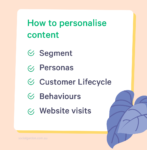BLOG
Content Personalisation 101

You might have heard about content personalisation in your travels around the digital marketing world. But what is it, exactly?
Read on for your crash course in content personalisation!
What is content personalisation?
Content personalisation is a form of one-to-one marketing, where the content delivered to each consumer is tailored to their preferences. This might look like an email that makes reference to their personal characteristics, such as their name, industry, or birthday.
The benefit of this form of curated marketing content is that customers feel valued and appreciated on a personal level, which is more likely to pique their interest in your product or service offering.
What are the benefits of content personalisation?
Other than delivering customised content to consumers, there are so many reasons why content personalisation is something you should consider implementing in your business practices.
Content personalisation benefits:
- Enhances the customer experience with tailored content that we know they’re interested in
- Increases customer engagement and website visits
- Builds trust and rapport through a meaningful customer experience
- Adds a human touch to all communication touchpoints
- Increases customer loyalty, and as a result increases customer lifetime value
- Shows consumers that the brand understands their needs and wants
- Can lead to higher ROI
- Leads the customer further down the purchase funnel
- Increases lead conversion
How can I personalise content?
Here, we’ve outlined 5 best-practice ways you can personalise content for your targeted audiences.
1. Segmentation
The first and most important way of personalising content is segmentation. It’s the process of grouping your audience like-with-like, based on things like interests or demographics. This allows for a more targeted marketing approach and ensures that each customer is only receiving content that is relevant to them personally.
You can segment an audience based on things like:
- Age
- Gender
- Location
- Industry/profession
- Search query
- Time and frequency of website visits
- Device type
It’s relatively easy to utilise CRM platforms to help personalise offers for particular segments based on birthdays, holidays, or membership anniversaries. The result? The customer feels as though your brand really knows them.
There are also other types of data that can help us with segmentation.
Firmographic data — data collected on an organisational level, such as industry, organisation size, location, and growth trends — also helps with B2B marketing, by personalising messages to the customer’s company affiliation.
Technographic data, on the other hand, gives us insight into a company’s technology capabilities. This can include their level of expertise in tech and the technological focus of their investments. In a B2B context, this is a great way of uncovering the needs of your audience and how your offering might cater to their needs.
2. Personas
Once you’ve created your desired audience segments, it’s easy to then create personas.
Personas take common clusters of demographics (or segments) and assign a semi-fictional personality to that group of potential customers. Personas group people together with similar buyer goals, journeys, and habits, and are a great way of tangibly visualising the audience you’re targeting. When a brand can understand and picture its ideal customer, it makes creating personalised content much easier.
3. Customer Lifecycle
Understanding where your customer sits within the purchase cycle is an important factor in delivering personalised content.
When we personalise content for customers based on their location in the sales funnel, it demonstrates the value we have for our customers while showing appreciation for their loyalty at every stage of their journey.
4. Behaviours
Personalising content based on a customer’s behaviour — that is, their activity on your organisation’s website, social media platforms, and their interactions with the call to action (CTA) — is another excellent method.
For this form of content personalisation, drip campaigns are very effective. They’re targeted to specific audiences, triggered by specific actions taken by the customer on your organisation’s pages (like sending an email to someone who puts an item in their basket without completing the checkout process). Basically, drip campaigns are a great way of helping turn visitors into buyers.
5. Website visits
To help provide relevant messages and content to each individual customer’s experience, we can use marketing technology solutions such as Marketo and craft each user touchpoint.
The personalisation of these platforms allows you to customise images, content, and offers based on the desired audience, ensuring that every website they visit is relevant to their needs.
It’s important to have your buyer personas ready when creating personalised website visits because they help inform each variant and page element. Things like knowing which device each buyer persona is likely to be using, and for how long they scrolled through your page, is instrumental in crafting the right experience for each target audience.
The best way to understand which part of your personalisation variants are resonating with your audience is to set up an A/B test. Different variations of subject lines, preheader texts, and other page elements can appeal to audiences in different ways.
How can I optimise marketing automation platforms for personalisation?
Navigating marketing automation platforms and tailoring them for content personalisation can be daunting at first, so here’s our step-by-step guide to creating dynamic content in-platform:
-
Right fields and values
Ensure the right fields and values are in place for each audience and the data you’re trying to collect from them.
-
Set up profiling campaigns
Profiling campaigns (like form fills) should be set up to gather data from the target audience. You can also use data scraping or web scraping here, which uses marketing elements (like social media platforms and purchase history) to extract consumer information. Progressive profiling is another option, which collects data on your audience over time.
-
Enable tagging or tracking methods
Website integrations can track cookies which help us better understand our target audience and aid with segmentation. Effective tracking measures also help with triggering email marketing activity in drip campaigns, which we mentioned earlier.
-
Segment your audience
Ensure an accurate audience segmentation, based on the ideal buyer persona, for the best results.
-
Ensure the right information is being tracked
Factors like name, industry, job title, and company name are pivotal in ensuring dynamic web personalisation on landing pages — and the more your database is populated with this kind of information, the more personalised your content will be.
-
Set up dynamic lists
These can further segment existing contacts in real-time, based on their demographics like location, age, and behaviour as details continue to be populated. These lists can then become part of your dynamic content strategy and help personalise your content based on age, region, or industry.














